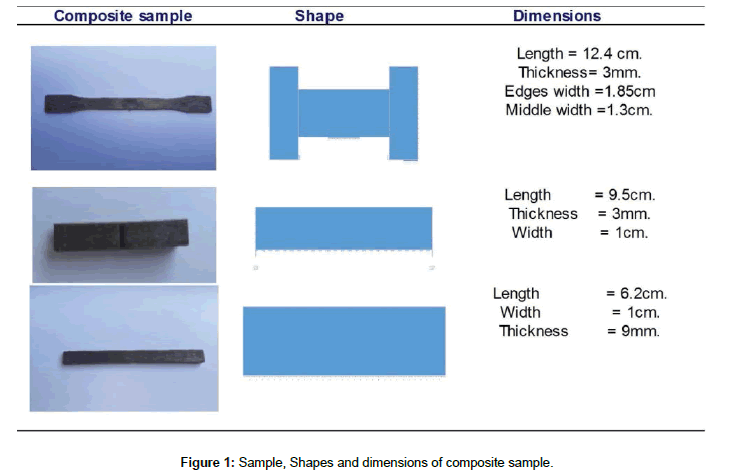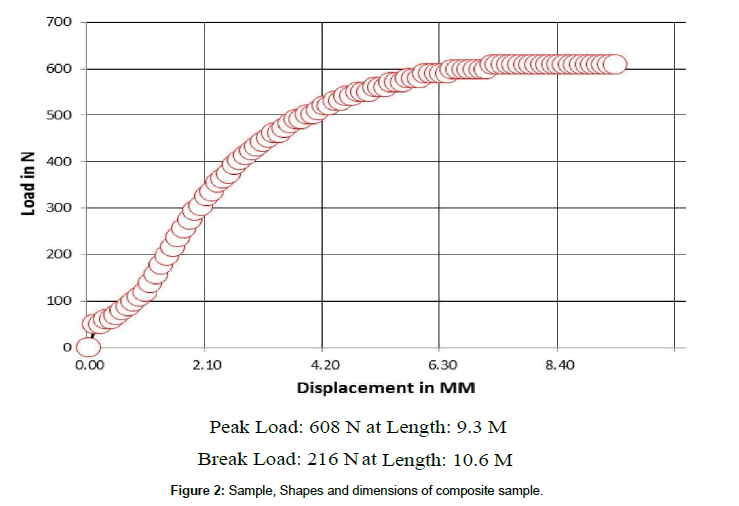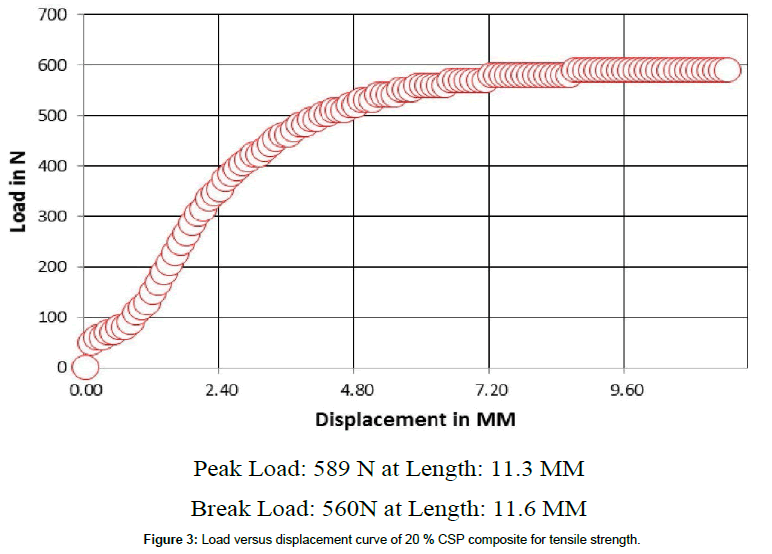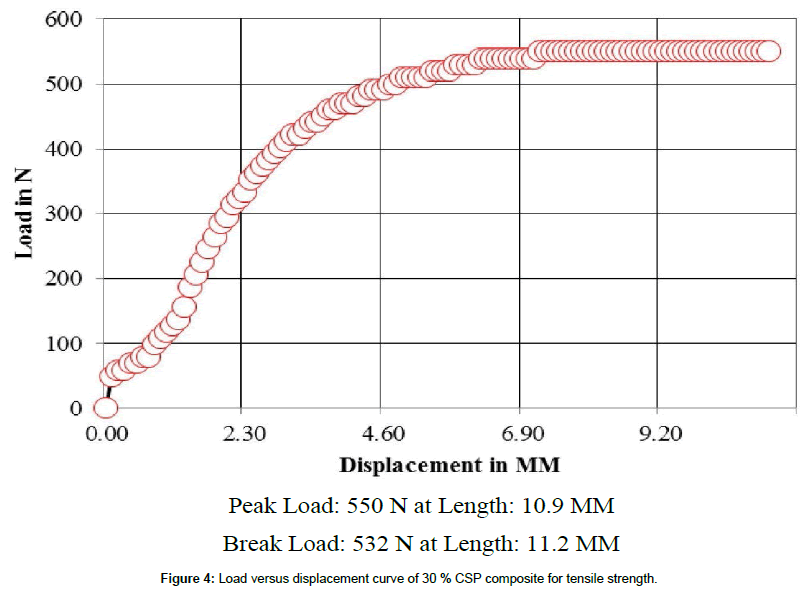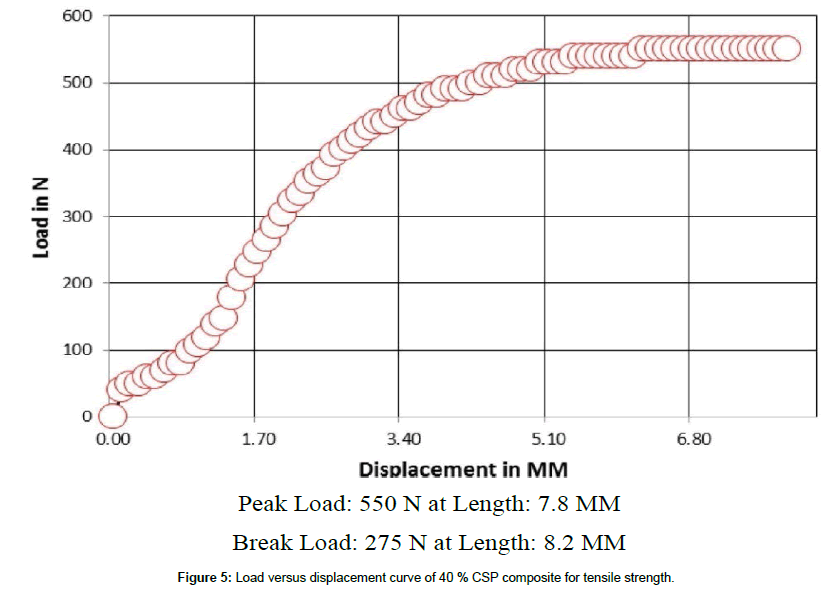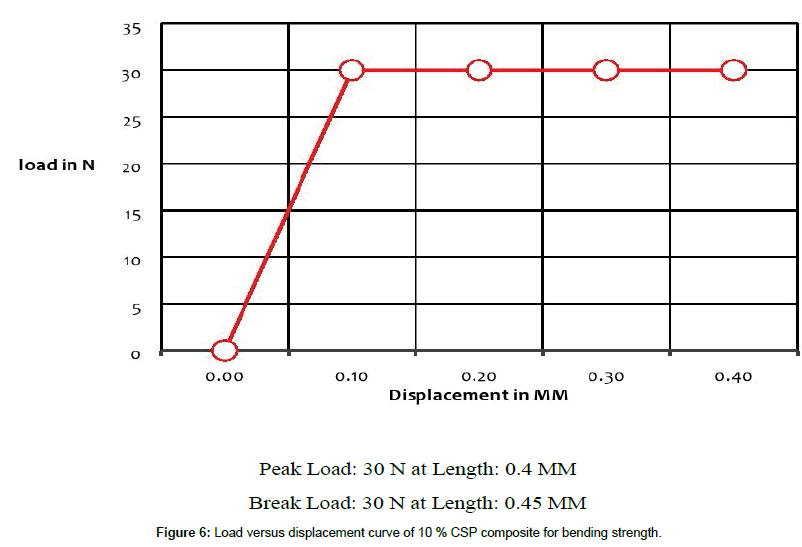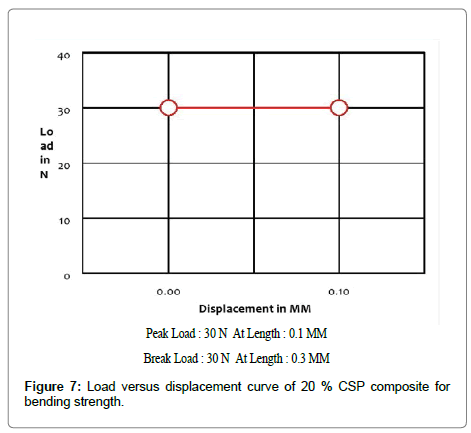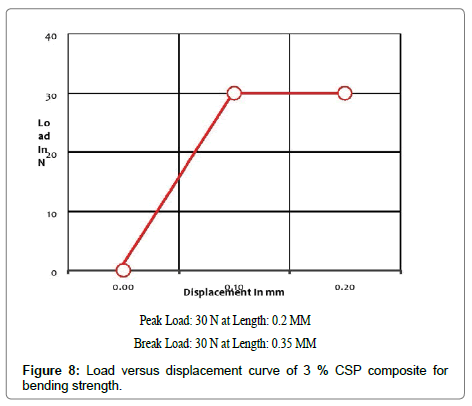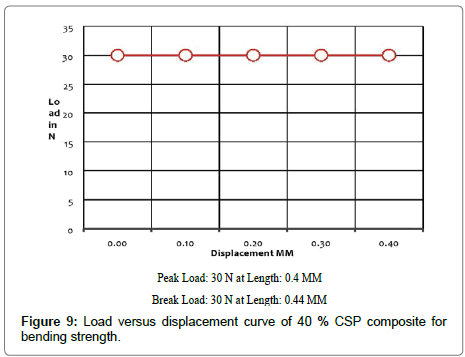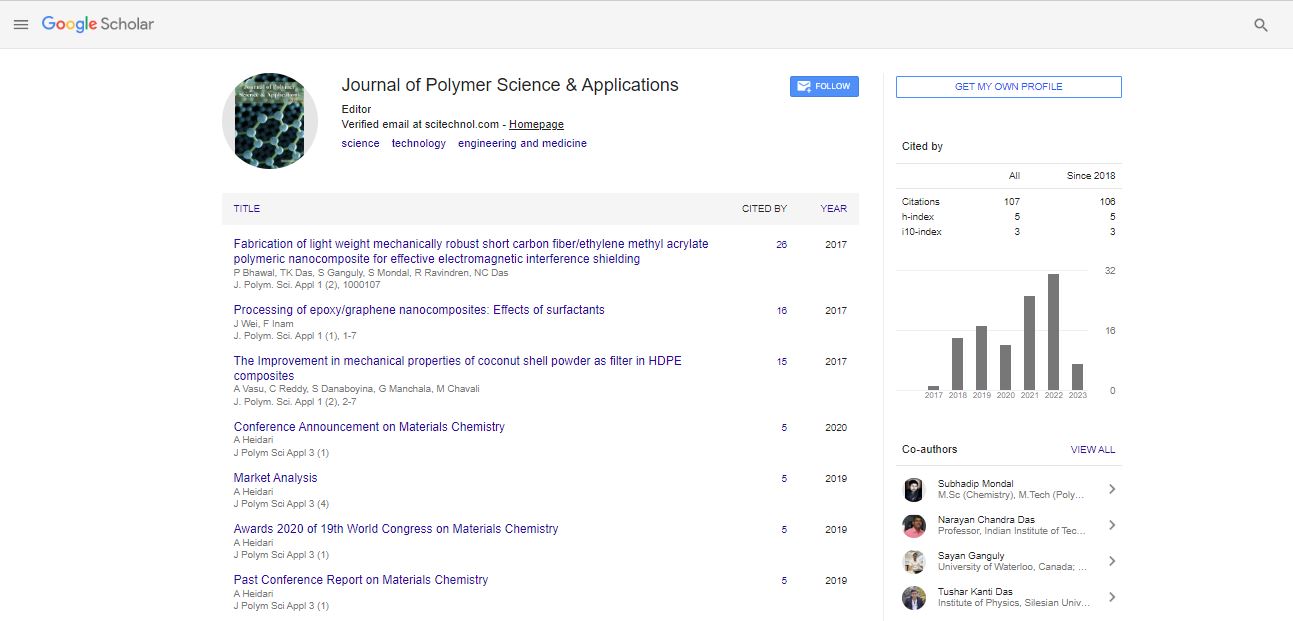Research Article, J Polym Sci Appl Vol: 1 Issue: 2
The Improvement in Mechanical Properties of Coconut Shell Powder as Filter in HDPE Composites
Aradhyula Thirumala Vasu1, Chetan Reddy, Srinadh Danaboyina2, Gopala Krishna Manchala2 and Murthy Chavali3*
1Department of Mechanical Engineering, National Chung Cheng University, Min Hsiung Township, Chiayi County, 62102 Taiwan
2Department of Mechanical Engineering, Vignan’s Foundation for Science, Technology and Research University (Vignan’s University), Vadlamudi, Guntur 522213, Andhra Pradesh, India
3Division of Chemistry, Department of Sciences and Humanities, Vignan’s Foundation for Science, Technology and Research University (Vignan’s University), Vadlamudi, Guntur 522213, Andhra Pradesh, India
*Corresponding Author : Murthy Chavali
Divisions of Chemistry, Department of Sciences and Humanities, Vignan’s Foundation for Science, Technology and Research University (Vignan’s University), Vadlamudi, Guntur 522 213, Andhra Pradesh, India
Tel: +91 96428 78182
E-mail: chavalim@gmail.com
Received: March 13, 2017 Accepted: April 14, 2017 Published: April 20, 2017
Citation: Vasu AT, Reddy C, Danaboyina S, Manchala GK, Chavali M (2017) The Improvement in Mechanical Properties of Coconut Shell Powder as Filter in HDPE Composites. J Polym Sci Appl 1:2.
Abstract
Composites have been prepared using the coconut shell powder and high-density polyethylene (HDPE) as the components. Coconut shell powder was mixed with HDPE via compounding of coconut shell powder and HDPE of HDPE and Coconut shell powder. The resultant materials were cast in three outlines and dried which resulted in composites. Their mechanical properties have been studied in detail and compared with the conventional composite made from the coconut shell powder used as reinforcement and high-density polyethylene (HDPE) which was used as a matrix. The resulting material can be used in the applications of Aerospace and Automobile etc.
Keywords: Coconut shell powder; Polyethylene matrix composite; Mechanical properties
Introduction
Composite materials were developed as a class of materials capable of advanced aerospace, electronics, structural, automotive and wear applications. This composite material used in our study was coconut shell powder and HDPE (High-Density Polyethylene). The advantage of the composite materials is their tailored mechanism which includes low density, high specific strength [1-4]. The top five coconut producing countries are Indonesia, Philippines, India, Brazil and Sri Lanka. The places in India include Gujarat, Maharashtra, Karnataka, Kerala, Tamil Nadu, Bihar, Andhra Pradesh, West Bengal, Orissa, and Assam. A coconut usually contains coconut water and core which is consumed and the remaining is left a shell as waste. These shells contain Natural fibers which are eco-friendly, biodegradables that are eco-friendly, cheap and renewable to the environment. Chemical composition of coconut shell powder consists of Lignin (29.4%), Pentosans (27.7%), Cellulose (26.6%), Moisture (8%), Solvent Extracts (4.2%), Uronic Anhydrides (3.5%) and Ash (0.6%) [5-9]. HDPE works like a hardener; the only type of polyethylene produced was LDPE. A German scientist (Karl Ziegler) made the greatest contribution in producing high-density polyethylene. The mechanical properties change drastically over high-density polyethylene to low density polyethylene. In general, the degree of branching in polyethylene determines its mechanical properties. HDPE is more crystalline than LDPE because it contains fewer branches. Unlike LDPE, a composite material which consists of coconut shell powder with different hardeners like coir fiber reinforced polyester composites, polymer matrix composites, Phenol Formaldehyde Epoxy Resin, and Polyester [10-16]. In this paper, the composites are tested by bending, impact and tensile tests.
Materials and Methods
Materials required for this composite are coconut shell powder and high-density polyethylene. The cleaned coconut shell was dried in open air; the pulverizing machine is used to make coconut shell into powder. High-density polyethylene, the only type of Low-Density polyethylene was produced at extremely high pressures. This highpressure polymerization created polyethylene with many branches; these branches are created due to intermolecular and intermolecular chain transfer during polymerization. The mechanism involved in the polymerization of low-density polyethylene is free radical polymerization. The uses of low-density polyethylene are limited due to the high number of branches. Because of the extreme pressure needed to create low-density polyethylene and its limited uses, Karl Ziegler tried in creating polyethylene at atmospheric pressure [17].
Coconut Shell powder and HDPE was used in ratios of, 10-90%, 20-80%, 30-70%, and 40-60% respectively. The various methods used in testing of composite materials are a tensile test, bending test and impact test.
The samples were prepared in different concentrations and in different shapes by the process of injection molding and casting technique for testing. These prepared samples were subjected to various mechanical tests like a tensile test, bending test and impact test.
Experimental Method
The powder was collected from dried coconut shell by breaking the shells into pieces and grinding them. The collected powder was sieved to different mesh sizes. The coconut shell powder is incorporated with high-density polyethylene by using injection molding and casting technique with the respective percentages of coconut shell powder. The ambient temperature of the high-density polyethylene is 200°C. The mixture was prepared into the required shape and size by using the molds of injection molding. All the samples will be tested through above mentioned tests, hence, a total of 15 pieces are required, the dimensions and shapes of those pieces are in Figure 1. The samples are tested for the mechanical properties; the samples which are compared with the standard, the one which matches with the standard it is acceptable for application in various mechanical fields (Tables 1-3).
| Composite sample | Peak load | Displacement |
|---|---|---|
| 10 % CSP filled | 608 | 9.3 |
| 20 % CSP filled | 589 | 11.3 |
| 30 % CSP filled | 550 | 10.9 |
| 40 % CSP filled | 550 | 7.8 |
Table 1: Load and displacement of tensile test composites.
| Composite sample | Tensile strength |
|---|---|
| 10% CSP filled | 15.2 |
| 20% CSP filled | 14.7 |
| 30% CSP filled | 13.8 |
| 40% CSP filled | 13.8 |
Table 2: Tensile strength of composite sample.
| Composite sample | Peak load | Displacement |
|---|---|---|
| 10% CSP filled | 30 | 0.4 |
| 20% CSP filled | 30 | 0.1 |
| 30% CSP filled | 30 | 0.2 |
| 40% CSP filled | 30 | 0.4 |
Table 3: Load and displacement of bending test Composites.
Results and Discussions
The experimental curves for tensile strength from Universal testing machine of 10% CSP (coconut shell powder) filled, 20% CSP filled, 30% CSP filled and 40% CSP filled composites are shown in Figures 2-5 respectively.
The tensile strength results in Table 3 for composite samples which are prepared with CSP filled and HDPE at different volume Fractions, the samples results are shown in load versus displacement curves in Figures 2-5, it illustrates that the maximum tensile strength is obtained from the composite prepared with 10 v% CSP volume fraction and the composite prepared with 40% CSP volume fraction has lower tensile strength.
The experimental curves for bending strength of Universal Testing Machine of 10% CSP filled, 20% CSP filled, 30% CSP filled and 40% CSP filled composites are shown in Figures 6-9 respectively.
The bending strength results in Table 4 for the composites which are prepared with CSP filled and HDPE at different volume Fractions, the samples results are shown in load versus displacement curves in Figures 6-9, it illustrates that the constant bending strength is obtained for the composites prepared with 10%, 20%, 30%, and 40% CSP volume fraction.
| Composite sample | Bending strength |
|---|---|
| 10% CSP filled | 0.8 |
| 20% CSP filled | 0.8 |
| 30% CSP filled | 0.8 |
| 40% CSP filled | 0.8 |
Table 4: Bending strength of composite sample.
The impact strength of 10% CSP filled, 20% CSP filled, 30% CSP filled and 40% CSP filled composites of its strengths are shown in the following Table 5.
| Composite sample | Impact strength |
|---|---|
| 10% CSP filled | 0.36 |
| 20% CSP filled | 0.38 |
| 30% CSP filled | 0.32 |
| 40% CSP filled | 0.32 |
Table 5: Impact strength of composite sample.
The impact strength results in Table 5 for composite sample which are prepared with CSP filled in HDPE at different volume fraction illustrate that the maximum impact strength is obtained for the composite prepared with 20% CSP volume fraction. The coconut shell powder HDPE composite with the higher fraction of filler 40% has lower strength [18-25].
Conclusion
The experimental characterization of Coconut shell powder for composite leads to the maximum tensile strength is obtained from the composite prepared with 10% CSP volume fraction and lower tensile strength is obtained for the composite prepared with 40% volume fraction of CSP, the bending strength is same for the all CSP volume fractions (i.e. 10%, 20%, 30% and 40%), the maximum impact strength is obtained from the composite prepared with 20% CSP volume fraction and lower strength is obtained for the composite prepared with 40% volume fraction. The composite is prepared with 10% to 20% Coconut shell powder for hybrid composite can be used as an alternative material for the interiors of aircraft, spacecraft, ships, electronics, and automobiles.
Acknowledgement
We have gratefully acknowledged the staff of V. R. Siddhartha College of Engineering, Vijayawada, Andhra Pradesh India for providing us with test facility. Authors also express their thankfulness to Mr. Manoj Kumar, former Junior Research Fellow & Ph.D. Scholar, Department of Biotechnology, VFSTR University, India and at present with Fachbereich Molekulare Biotechnologie (FH Campus Wien; https://www.fh-campuswien.ac.at/), Wien, Austria for his help while preparing the samples.
References
- Monteiro SN, Lopes FPD, Ferreira AS, Denise CON (2009) Natural-fiber polymer-matrix composites: Cheaper, tougher, and environmentally friendly. J Mat 61: 17-22
- Rout J, Mishra M, Tripathi SS, Nayak SK, Mohanty AK (2001) The influence of fibre treatment on the performance of coir-polyester composites. Compos Sci Technol 61: 1303-1310
- Rana AK, Mandal A, Bandyopadhyay S (2003) Short Jute Fiber Reinforced Polypropylene Composites: Effect of Compatibiliser, Impact Modifier and Fiber Loading. Composites Science and Technology 63: 801-806.
- Jawaid M, Abdul Khalil HPS, Abu Bakar A (2010) Mechanical performance of oil palm empty fruit bunches/jute fibres reinforced epoxy hybrid composites. Mat Sci Engg A 527: 7944-7949.
- Eichhhorn SJ, Baillie CA, Zafeiropoulos N, Mwaikambo LY, Ansell MP et al. (2001) Review: Current international research into cellulosic fibres and composites. J of Mat Sci 36: 2107-2113.
- Norlia MI, Roshazita CA, Nuraiti TIT, Salwa MZM, Fatimah MSS (2011) Mechanical Properties of Activated Carbon (AC) Coconut Shell Reinforced Polypropylene Composites Encapsulated with Epoxy Resin. APCBEE Procedia 9: 92-96.
- Mohan D, Pitmann CU Jr (2006) Activated carbons and low cost adsorbents for remediation of tri- and hexavalent chromium from water. J Hazard Mater 137: 762-811.
- Andrzej KBA, Abdullah AM, Jürgen V (2010) Barley husk and coconut shell reinforced polypropylene composites: The effect of fibre physical, chemical and surface properties. Compos Sci Technol 70: 840-846.
- Joseph PV, Mathew G, Joseph K, Groeninckx G, Thomas S, et al. (2003) The thermal and crystallisation studies of short sisal fibre reinforced polypropylene composites. Composites Part A 34: 275-290.
- Idicula M, Joseph K, Thomas S (2010) Mechanical Performance of Short Banana/Sisal Hybrid Fiber Reinforced Polyester Composites. J Reinf Plast Comp 29: 12-29.
- Gulbarga MA, Burli SB (2013) Jute Fiber-PP Bio-Composite: State of art, low investment, in house and manual preparation of injection moldable bio-composite granules. Int J Sci Res 3: 1-6.
- Kasama J, Nitinat S (2009) Effect of glass fiber hybridization on properties of sisal fiber polypropylene composites. Composites Part B 40: 623-627.
- Joshi SV, Drzal LT, Mohanty AK, Arora S (2004) Are natural fiber composites environmentally superior to glass fiber reinforced composites? Composites Part A 35: 371-376.
- Roe PJ, Ansell MP (1985) Jute-reinforced polyester composites. J Mat Sci 20: 4015-4020.
- Alok S, Savita S, Aditya K (2013) Study of mechanical properties and absorption behaviour of coconut shell powder-epoxy composites. Int J Mat Sci App 2: 157-161.
- Girisha C, Sanjeevamurthy, Gunti R (2012) Tensile properties of natural fiber reinforced epoxy-hybrid composites. Int J Modern Engg Res 2: 471-474.
- Sworen JC (2004) Modeling Linear-Low Density Polyethylene: Copolymers Containing Precise Structures. PhD Thesis, University of Florida, USA.
- Swain PTR, Biswas S (2014) Physical and Mechanical Behavior of Al2O3 Filled Jute Fiber Reinforced Epoxy Composites. Int J Current Engg Tech 2: 67-71.
- Soma D, Acharya SK (2014) Study on mechanical properties of natural fiber reinforced woven jute-glass hybrid epoxy composites. Adv in Polym Sci Techn 4: 1-6.
- Soma D, Acharya SK (2015) Effect of cenosphere addition on erosive wear behavior of jute- glass reinforced composite using taguchi experimental design. Materials Today: Proceedings 2: 2389-2398.
- Hossain MR, Islam MA, Vuurea AV, Verpoest I (2013) Effect of fiber orientation on the tensile properties of jute epoxy laminated composit. J Sci Res 5: 43-54.
- Banakar P, Shivananda HK, Niranjan HB (2013) Effect of Fillers on E-Glass/Jute Fiber Reinforced Epoxy Composites. Int J Pure and Applied Sci Tech 9: 61-68.
- Bhaskar J, Singh VK (2013) Physical and Mechanical Properties of Coconut Shell Particle Reinforced-Epoxy Composite. J Mater Environ Sci 4: 227-232.
- Naresh KK, Prasanth KM, Krishna V, Srinivasa RD (2013) Experimental Investigation on Mechanical Properties of Coal Ash Reinforced Glass Fiber Polymer Matrix Composites. Int J Emerging Tech Adv Engg 3: 250-258.
- Asuke F, Abdulwahab M, AigbodionVS, Fayomi OSI, Aponbiede O (2014) Effect of load on the wear behaviour of polypropylene/carbonized bone ash particulate composite. Egypt J Basic Appl Sci 1: 67-70
 Spanish
Spanish  Chinese
Chinese  Russian
Russian  German
German  French
French  Japanese
Japanese  Portuguese
Portuguese  Hindi
Hindi 